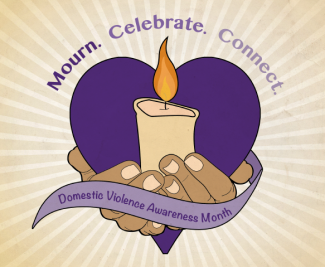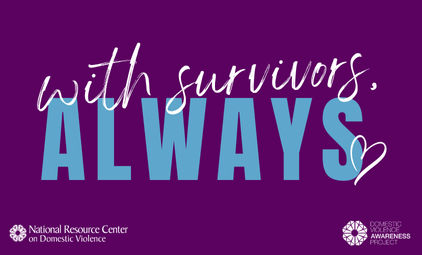Each year, during the month of October, domestic violence victim advocates, survivors and their loved ones, allies, and the general public join together to mourn the lives lost, celebrate the progress being made, and connect their efforts to put an end to violence in intimate relationships. Programs of all sizes, and individuals across the nation, can take part in raising awareness of this issue—even on a shoestring budget and with very little time. Join us for this webinar to learn how!
The Pressure Is On: Ready for DVAM 2014?
Monday, September 22, 2014
3pm Eastern/2pm Central/1pm Pacific
Register now: https://bwjp.ilinc.com/register/hthcrjx
Through participation in this webinar, presented by the Capacity Building and Education Team at the National Resource Center on Domestic Violence, participants will:
- Receive planning tools to host a successful awareness event,
- Learn how to effectively support survivors who speak out about their experiences, and
- Review tips on how to interact with the media.
For information, inspiration and materials on raising awareness during DVAM and throughout the year, visit the Domestic Violence Awareness Project website.

SAVE THE DATE: NATIONAL CALL OF UNITY
On this free 45-minute call, several national organizations, governmental agencies, local domestic violence programs, advocates, allies, survivors and their family and friends come together to connect and refocus our efforts to end domestic violence and sexual assault. Each year, callers dial in to join the call and listen together in counseling centers, domestic violence shelters, rape crisis centers, meeting rooms, at school, at home, and at many other gatherings.
Join with us on Tuesday, October 7th at 3pm Eastern/2pm Central/12pm Pacific. More details will be available soon!

BROCHURE TEMPLATES
Updated generic brochures, designed to be used or adapted by local programs, state coalitions, educators, allied professionals, and the general public, are now available.
Finding Safety and Support reviews helping resources for victims experiencing domestic violence in gender-neutral language, and is designed to be shared with victims or survivors.
Helping End Domestic Violence describes how individuals and the community can assist in efforts to end domestic violence, and is designed to provide basic information that can be shared with a variety of audiences.

PROTECTING SURVIVORS’ PETS
According to the 2013-2014 National Pet Owners Survey, 68% of U.S. households, or 82.5 million homes, include a companion animal. In most cases, these companion animals are cherished members of the family. Other studies reveal that up to 70% of domestic violence victims report having a pet, and when a batterer causes violence in the home, it can be inflicted on pets as well.
Technical Assistance Guidance:
Why Pets Mean So Much: The Human-Animal Bond in the Context of Intimate Partner Violence by the Animal Welfare Institute for the National Resource Center on Domestic Violence (September 2014) explores ways that victim advocates can assist survivors of domestic violence and their pets when seeking safety and refuge from abuse.
Webinar Recording:
Sheltering Animals and Families Together: Expanding safety and support services for survivors while helping to protect their pets, presented by Allie Phillips, Sheltering Animals and Families Together Program (SAF-T Program) (July 2014) reviews the linkage between the urgent need to protect domestic violence victims and their pets from further abuse, and the comfort that pets can provide, especially in times of stress and trauma.
DVAM Campaign:
National Sheltering Animals and Families Together (SAF-T) Day is a guide for planning a local event for National SAF-T day during DVAM. Details and variations on the theme are offered for adaptation.
Media Talking Points:
How and why are domestic violence and animal abuse related? (August 2014) is a media talking points form designed for use during DVAM and beyond. It offers key points, statistics with references, and opportunities to provide case examples from your community.

INTIMATE PARTNER HOMICIDE PREVENTION
Intimate Partner Homicide Prevention by The National Resource Center on Domestic Violence (Updated July 2014)
This Special Collection explores the most tragic consequence of domestic violence and offers a variety of tools and information towards its prevention. The collection outlines the scope of the problem; provides an overview of tools and strategies for assessing danger or the risk of lethality in domestic violence cases; recommendations and approaches for utilizing the fatality review process to prevent intimate partner homicide; materials describing various systems’ responses to domestic violence and efforts to prevent homicide; resources to assist advocates in helping to frame the issue through media response and community mobilization; and resources addressing the grief and trauma experienced by loved ones of those whose lives are lost to domestic violence.

TRAUMATIC BRAIN INJURY
Traumatic Brain Injury and Domestic Violence: Understanding the Intersections by the National Resource Center on Domestic Violence (Updated June 2014)
This Special Collection offers information about the intersection between domestic violence and Traumatic Brain Injury (TBI). It provides advocates and other professionals with tools to screen for TBI within the context of domestic violence as well as presentations, articles, and other relevant resources on the topic.
The purpose of this collection is to: 1) increase knowledge and understanding of TBI within the context of domestic violence, 2) provide tools to advocates and other professionals to screen domestic violence survivors for TBI, and 3) highlight best practices.

DISASTER PREPARATION
Disaster and Emergency Preparedness and Response: Resources for Victims of Domestic and Sexual Violence and their Advocates by the National Resource Center on Domestic Violence (Updated June 2014)
Included in this collection are selected materials and resources — many gender-informed — that can be used by domestic and sexual violence organizations to increase their preparedness for and response to major disasters and emergencies. Also included is information developed for victims/survivors of domestic and sexual violence who are concurrently coping with trauma and stress after a natural disaster or major crisis. Special attention has been given to the issues faced by children in these situations.

ECONOMIC SECURITY
In a series of five new reports, the Women of Color Network (WOCN) examines the overarching economic barriers facing survivors of violence – and how we can all respond through enhanced policies, programs, and advocacy so as to ensure survivor safety and economic access.
The 2014 WOCN Reports from the Field emerged from advocate expertise during the 2011 National Economic Policy and Leadership Summit and a series of three regional convenings in 2013. The reports explore Strengthening Institutional Services; the need for Policy Advocacy; Reentry Populations; Tribal Sexual Assault; and T- and U-Visas, and present the direct expertise of advocates working to end violence across the country. The reports provide background, a scope of the problem, and offer targeted recommendations for advocates, agencies, and policymakers.

PreventIPV WEBINARS
Register Now:
Selling Social Change: Exploring What Works in Making the Case for Prevention – September 18th at 2pm Eastern/1pm Central/12pm Pacific
The PreventIPV Project has engaged a handful of advocates and preventionists in a series of focus groups and interviews to gain insight into what works, and what is needed, in order to best make the case for prevention–to funders and foundations, businesses and non-traditional partners, communities, policy makers, and in our own movement minds. On this webinar, the PreventIPV Council and allies will share key, preliminary findings from these discussions, invite participants to offer their insights, and explore successful models of engagement in Washington and Texas.
Recording Available:
Introducing PreventIPV: Tools for social change hosted by PreventConnect (June 23, 2014)
This webinar highlighted PreventIPV, a project of the IPV Prevention Council. PreventIPV actively supports a unified national prevention movement promoting best practice strategies, tools, and lessons learned by state/territory coalitions and community-based prevention programs across the United States. Learn from two innovative prevention strategies that have been formally evaluated and found effective, and experience Tools for Social Change, an interactive web-based portal and compendium of IPV prevention resources.
![]()
TA QUESTIONS OF THE MONTH
Read and comment on these recent requests received by the National Sexual Violence Resource Center and National Resource Center on Domestic Violence!
September 2014: How can I make my center an affirming place for people who identify as LGBTQ?
Promoting equality for LGBTQ people is central to gender based violence prevention. And making the effort to de-institutionalize unseen oppressive factors in our own organizations is a necessary first step. Read on.
August 2014: How can I support adult survivors of child sexual abuse when their trauma resurfaces?
The stress of experiencing a sexual trauma in childhood can impact a person’s health across their lifespan. After the abuse, survivors often have to get creative in finding ways to deal with trauma that resurfaces. Read on.
July 2014: How can I support pregnant survivors accessing services?
The expectation is not that all advocates become birth workers, but the goal should be to become better informed about where and how to guide pregnant survivors to the healthcare resources they need to feel respected, heard, and treated with dignity as they bring new life into this world. Read on.
NEW ON VAWNET
Recent additions to the VAWnet library include:
Screening for Human Trafficking: Guidelines for Administering the Trafficking Victim Identification Tool by Vera Institute of Justice (June 2014)
Representing Victims of Intimate Partner Violence Connected with the Military: A Handbook for Civil Attorneys by Ellen C. Schell for the Battered Women’s Justice Project (June 2014)
Responding to Transgender Victims of Sexual Assault by FORGE and the Office for Victims of Crime (June 2014)
Elder Justice Roadmap Project Report by the National Center on Elder Abuse (July 2014)
Share the Eight Infographic by Beauty Cares (2014)
Preventing Youth Violence: Opportunities for Action by Corinne David-Ferdon and Thomas R. Simon for the National Center for Injury Prevention and Control, Centers for Disease Control and Prevention (June 2014)
Engaging Men as Allies in Prevention by The North American MenEngage Network (NAMEN) (June 12, 2014)
Understanding the Link between Violence to Animals and People: A Guidebook for Criminal Justice Professionals by Allie Phillips for the National District Attorneys Association (June 2014)
The 2014 Trafficking in Persons Report by the U.S. Department of State (June 2014)
| As part of a social change movement to end gender-based violence, the NRCDV engages with and learns from, informs, and supports systems, organizations, communities, and individuals to strengthen capacity to effectively address domestic violence and intersecting issues. |















